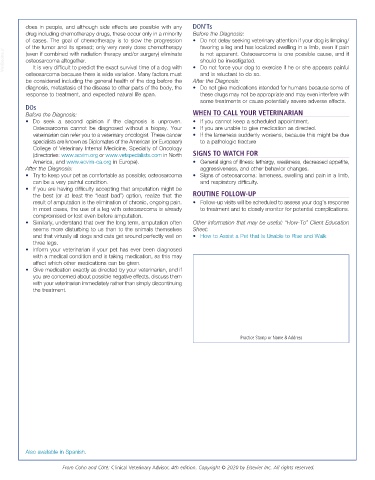Page 3092 - Cote clinical veterinary advisor dogs and cats 4th
P. 3092
does in people, and although side effects are possible with any DON’Ts
drug including chemotherapy drugs, these occur only in a minority Before the Diagnosis:
of cases. The goal of chemotherapy is to slow the progression • Do not delay seeking veterinary attention if your dog is limping/
of the tumor and its spread; only very rarely does chemotherapy favoring a leg and has localized swelling in a limb, even if pain
VetBooks.ir osteosarcoma altogether. • Do not force your dog to exercise if he or she appears painful
is not apparent. Osteosarcoma is one possible cause, and it
(even if combined with radiation therapy and/or surgery) eliminate
should be investigated.
It is very difficult to predict the exact survival time of a dog with
osteosarcoma because there is wide variation. Many factors must and is reluctant to do so.
be considered including the general health of the dog before the After the Diagnosis:
diagnosis, metastasis of the disease to other parts of the body, the • Do not give medications intended for humans because some of
response to treatment, and expected natural life span. these drugs may not be appropriate and may even interfere with
some treatments or cause potentially severe adverse effects.
DOs
Before the Diagnosis: WHEN TO CALL YOUR VETERINARIAN
• Do seek a second opinion if the diagnosis is unproven. • If you cannot keep a scheduled appointment.
Osteosarcoma cannot be diagnosed without a biopsy. Your • If you are unable to give medication as directed.
veterinarian can refer you to a veterinary oncologist. These cancer • If the lameness suddenly worsens, because this might be due
specialists are known as Diplomates of the American (or European) to a pathologic fracture
College of Veterinary Internal Medicine, Specialty of Oncology
(directories: www.acvim.org or www.vetspecialists.com in North SIGNS TO WATCH FOR
America, and www.ecvim-ca.org in Europe). • General signs of illness: lethargy, weakness, decreased appetite,
After the Diagnosis: aggressiveness, and other behavior changes.
• Try to keep your pet as comfortable as possible; osteosarcoma • Signs of osteosarcoma: lameness, swelling and pain in a limb,
can be a very painful condition. and respiratory difficulty.
• If you are having difficulty accepting that amputation might be
the best (or at least the “least bad”) option, realize that the ROUTINE FOLLOW-UP
result of amputation is the elimination of chronic, ongoing pain. • Follow-up visits will be scheduled to assess your dog’s response
In most cases, the use of a leg with osteosarcoma is already to treatment and to closely monitor for potential complications.
compromised or lost even before amputation.
• Similarly, understand that over the long term, amputation often Other information that may be useful: “How-To” Client Education
seems more disturbing to us than to the animals themselves Sheet:
and that virtually all dogs and cats get around perfectly well on • How to Assist a Pet that Is Unable to Rise and Walk
three legs.
• Inform your veterinarian if your pet has ever been diagnosed
with a medical condition and is taking medication, as this may
affect which other medications can be given.
• Give medication exactly as directed by your veterinarian, and if
you are concerned about possible negative effects, discuss them
with your veterinarian immediately rather than simply discontinuing
the treatment.
Practice Stamp or Name & Address
Also available in Spanish.
From Cohn and Côté: Clinical Veterinary Advisor, 4th edition. Copyright © 2020 by Elsevier Inc. All rights reserved.

